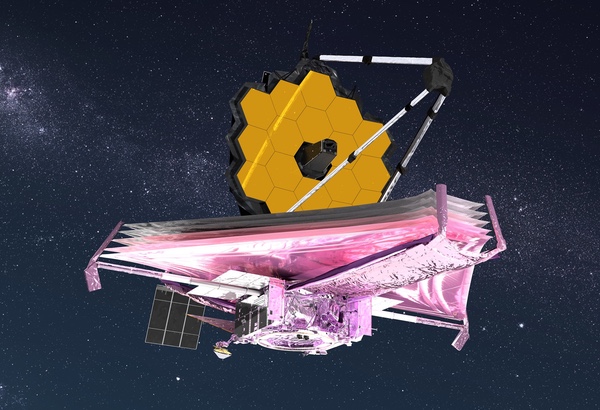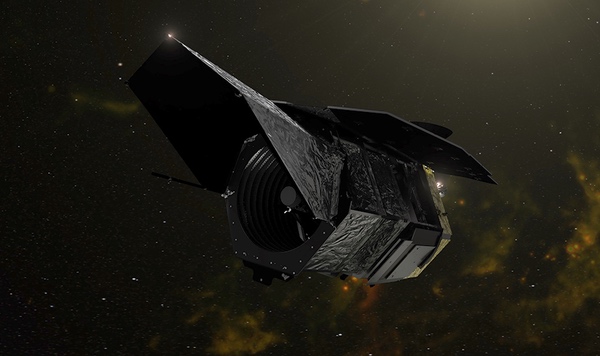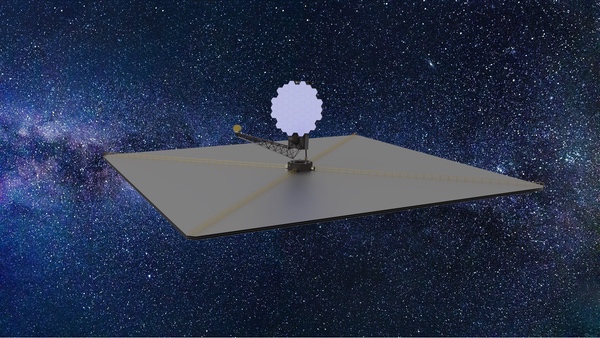 The success of JWST, exceeding requirements in nearly every way, allows NASA to focus now on development of future large space telescopes. (credit: NASA GSFC/CIL/Adriana Manrique Gutierrez) |
Unlocking the next great observatories
by Jeff Foust
Monday, January 16, 2023
When astronomers gathered in Seattle last week for the 241st Meeting of the American Astronomical Society (AAS), one of the largest conferences of astronomers, there was a celebratory mood among many there. The meeting was the first by the AAS since the release last July of the first science images from the James Webb Space Telescope that marked the start of a new era in the field after years—decades, really—of anticipation.
JWST was front and center for much of the conference. Astronomers presented new research from early observations by the telescope, from the discovery of a rocky, Earth-sized exoplanet to distant early galaxies. After years of anticipating what JWST could do, they were now starting to reap the benefits that had long been promised.
| “JWST was artisanal. It’s really made by hand,” Rigby said. “That scientific performance that is better than expectations is because of a tremendous amount of work by 20,000 people around the world.” |
In presentations at the meeting, project scientists and managers said the telescope continued to meet or exceed requirements. “The high-level message is that it really is better than we expected across the board,” said Jane Rigby, operations project scientist for JWST at NASA’s Goddard Space Flight Center, in a plenary talk January 9 that ended with a prolonged standing ovation.
The telescope, she said, was doing far better than required on factors such as sensitivity, stability, and resolution. The accuracy of its launch a little more than a year ago on an Ariane 5 reduced the need to use propellant for course corrections on its way to the Earth-Sun L-2 point. She said NASA now estimates it has enough stationkeeping propellant to operate for more than 20 years, double the agency’s estimates before launch.
She credited that performance to the attention to detail during its construction. “JWST was artisanal. It’s really made by hand,” she said. “That scientific performance that is better than expectations is because of a tremendous amount of work by 20,000 people around the world.”
At a town hall meeting for JWST held at the conference January 9, project officials did discuss some minor issues with the telescope. One that had attracted attention even during spacecraft commissioning was micrometeoroid impacts on the telescope’s mirror segments, including one in May that was larger than anticipated.
Jonathan Gardner, deputy senior project scientist for JWST at NASA Goddard, said there have been 21 micrometeoroid impacts to date, only one large enough to be of any concern. Combined, he said, they have had “only a very small effect” on image quality, which continues to exceed expectations.
To reduce the impact risk, he said NASA will change how the telescope operates starting with the next cycle of observations this summer. NASA will avoid pointing the mirrors in the direction of the telescope’s motion to avoid head-on impacts with micrometeoroids. That will affect the timing of some observations, although he said there will be exceptions for time-sensitive observations.
Other minor issues have mostly been resolved. That included a problem with a grating wheel on its Mid-Infrared Instrument (MIRI) that showed increased friction, but has been addressed by using a different movement pattern. A software glitch put the telescope briefly into safe mode in December because of what Gardner described as an “unusual series of events”; that was the only such incident since science operations began last summer.
The biggest concern, at least among some astronomers, is not with JWST itself but its name. Several years ago, a group of astronomers called on NASA to rename the telescope, arguing that James Webb directed, or was at least complicit in, the firings of LGBTQ employees at NASA when he was administrator in the 1960s and, earlier, as a high-ranking official at the State Department during the “Lavender Scare” of the 1950s.
| “At this AAS, where we’re really taking a victory lap and celebrating JWST, I put on a tie because I wanted to wear my JWST tie pin. Just this once,” Clampin said. |
NASA investigated the allegations and concluded in 2021, shortly before the telescope’s launch, that there was no evidence to support those claims. Critics, though, pushed back, citing the limited information—a brief statement and nothing more—NASA provided at the time. By last October, the UK’s Royal Astronomical Society, expressing its displeasure with the lack of details on the investigation, announced it would instruct authors submitting papers for publication in its journals to refer to the telescope only as JWST, rather than spelling out the acronym as would normally be required.
In November, NASA released the final report by the agency’s chief historian Brian Odom, into that investigation. “In conclusion, to date, no available evidence directly links Webb to any actions or follow-up related to the firing of individuals for their sexual orientation,” he wrote in the report, describing research that included searches of historical archives that showed that Webb was either unaware of the firings or focused more on limiting access to State Department personnel records from congressional investigations.
NASA confirmed it has no plans to rename JWST. “Based on the available evidence, the agency does not plan to change the name of the James Webb Space Telescope,” it stated when it released the historical report. Some astronomers continue to criticize that decision, unconvinced by the report. However, the Royal Astronomical Society said in December it would now allow authors to refer to JWST by its full name in papers, if they so choose.
“We took that very seriously,” Mark Clampin, director of NASA’s astrophysics division, said at a town hall meeting at the AAS conference January 9 when asked about JWST’s name. “The conclusion of the NASA historian was that there just wasn’t enough evidence to warrant changing the name of the telescope.”
He added, though, that NASA was rethinking how it names large missions like JWST, which broke from a tradition of naming space telescopes after astronomers. “The agency is considering a process for future naming of observatories,” he said. “That has not been completed, but it is obviously under discussion.”
 The Roman Space Telescope, scheduled for launch as soon as 2026, will study cosmology and exoplanets, while also demonstrating NASA can eliver a mission on cost and schedule. (credit: NASA GSFC/SVS) |
Roman and the New Great Observatories
Clampin took over as astrophysics division director in August, succeeding longtime director Paul Hertz who moved to a new advisory role in the agency’s Science Mission Directorate. He took the stage at the town hall meeting in a jacket and tie, unusually formal attire for a conference where ties are often outnumbered by tie-dyed t-shirts.
There was good reason, he said, for the tie. “At this AAS, where we’re really taking a victory lap and celebrating JWST, I put on a tie because I wanted to wear my JWST tie pin. Just this once.”
The town hall and the overall conference, though, was more than taking a victory lap for JWST. With that telescope working well in space, the attention of Clampin, NASA, and the overall astronomical community was turning to the flagship space telescopes that will follow it.
That starts with the Nancy Grace Roman Space Telescope, a mission recommended by the 2010 astrophysics decadal survey as the Wide-Field Infrared Survey Telescope (WFIRST). NASA renamed WFIRST in 2020 after Roman, the agency’s first chief of astronomy who oversaw the development of a series of initial astrophysics missions by the agency and laid the groundwork in the 1960s for a mission called the Large Space Telescope, which became the Hubble Space Telescope. (Unlike JWST, there is no controversy around the name of this mission, often referred to simply as Roman.)
“If you ask me what my highest priority is right now, it’s the Roman Space Telescope,” Clampin said at the town hall meeting. Part of that is driven by the science promised by Roman, including studies of dark matter and dark energy as well as searches for exoplanets to help constrain the number of stars that have planets with sizes and orbits similar to the Earth.
| “We’re on track, and that is the best news ever,” said McEnery of Roman. |
There is also a programmatic imperative for Roman: for NASA to demonstrate it has learned the lessons of JWST, which ran far over budget and far behind schedule. “We have to demonstrate that we can build these flagships on cost and schedule.”
The good for NASA is that, despite some challenges early in its development, and later threats of cancellation during much of the Trump Administration, Roman is making good progress. “We’re really comfortable with where we are with Roman right now,” he said.
Project officials echoed that assessment at a mission town hall meeting the next evening at the conference. “We’re on track, and that is the best news ever,” said Julie McEnery, NASA senior project scientist for Roman. Roman has a launch readiness date of May 2027, but is currently targeting a launch in October 2026.
NASA is starting planning for the flagship that will follow Roman. The Astro2020 decadal survey, published in November 2021, had recommended NASA pursue a series of space telescopes, starting with a large observatory with a mirror six meters across that could operate in ultraviolet, visible, and near-infrared wavelengths. That mission, with an estimated cost of $11 billion, would likely be ready for launch in the early 2040s (see “A new approach to flagship space telescopes”, The Space Review, November 29, 2021).
 NASA has not released a design concept for the Habitable Worlds Observatory, but it will be somewhat smaller than one of the space telescope concepts, LUVOIR, proposed for the Astro2020 decadal survey. (credit: NASA GSFC) |
That telescope would be followed in succession by two others, one operating in the far infrared and the other in X-rays; the three combined are called the New Great Observatories by some astronomers. Before NASA starts development of any of them, though, the report recommended it establish a program to mature key technologies in advance of their development, ensuring they are ready when needed and don’t contribute to cost and schedule overruns.
Astro2020 did not provide a name for that initial large telescope it recommended. NASA, for a time after the decadal’s publication, referred to it by the acronym IROUV, for infrared, optical, ultraviolet; the name wasn’t well-received among astronomers in part because “ear-roov” didn’t exactly roll off the tongue.
Starting last fall, and without any public pronouncements, NASA started calling that future space telescope the Habitable Worlds Observatory. “We basically had to start using something because we had been having a lot of discussions with our stakeholders,” Clampin said at the NASA town hall meeting, emphasizing that the moniker is only a working name for now.
The name, he said, is meant to capture one of the primary goals of the space telescope, to detect habitable exoplanets. The “observatory” part of the name, he added, reflects that it will also be able to perform a wide range of general astrophysics.
NASA is still several years away from formally starting Habitable Worlds Observatory as a project. However, Clampin said he has already established several principles that will guide its development. First on the list was to “build to schedule,” or making a launch by a specific date a top requirement. “We’re going to treat the mission like a planetary mission that has a launch window,” he explained. “We mature the technologies and then we set the schedule.”
NASA plans to mitigate technology risks by evolving technologies already demonstrated, or will be demonstrated on upcoming missions, the second principle Clampin outlined. “We currently have a TRL 9 telescope orbiting L-2 that’s six meters in diameter,” he said, referring to JWST. (TRL refers to technology readiness level, measured on a one-to-nine scale where nine refers to something with flight heritage.) That technology will be applied to the Habitable Worlds Observatory, along with a coronagraph instrument being built for Roman.
Two other principles involve how the telescope will be launched and operated. He said NASA expects to use “next-generation” launch systems with increased payload mass and volume that can accommodate larger telescopes and simplify their design, limiting the origami-style deployments needed for JWST. “We would be insane not to use them,” he said of those rockets. “Big fairings on big rockets give you flexibility.”
Habitable Worlds Observatory, unlike JWST, will be designed to be serviced, with Clampin citing a “veritable gold rush” of commercial satellite servicing activities that NASA expects will be available when the spacecraft is ready for launch. That includes not just refurbishing the telescope but also updating its instruments as capabilities evolve, or if some instruments aren’t ready in time for launch.
| “We would be insane not to use them,” Clampin said of future large rockets. “Big fairings on big rockets give you flexibility.” |
The final two principles call for maturing technologies for the mission before entering development, but also including “robust” margins to accommodate both scientific and technical uncertainties, like the number of stars the mission will have to observe to get a sufficient number of potentially habitable worlds.
Maturing technologies is a key focus now for NASA in the future development of the Habitable Worlds Observatory. In response to the decadal survey’s recommendations, the agency established the Great Observatory Technology Maturation Program, or GOMAP, to identify and advance the technologies needed for Habitable Worlds Observatory as well as the proposed far-infrared and X-ray flagships.
NASA has completed the first of three stages of GOMAP, a largely organizational step to plan out future work, and is ready to move into stage two, a concept maturation study for Habitable Worlds Observatory. Julie Crooke, program executive for GOMAP at NASA Headquarters, said during a January 9 conference session that the agency will soon seek nominations to serve on a Science, Technology, Architecture Review Team (START) to support that work.
The purpose of START, she said, is to look at the various ways of adjusting science goals, technologies, and overall architecture to optimize the design of the mission. “We really want to look at the whole option space,” she said. She expects to have 20 to 30 people on START with a wide range of science and engineering backgrounds, augmented by independent consultants with expertise in cost estimation and scheduling.
A notional schedule she showed at the meeting had stage two of GOMAP running through the end of fiscal year 2024. That would be followed by a third stage lasting four years to perform pre-Phase A work on Habitable Worlds Observatory, allowing it to enter Phase A of development in fiscal year 2029.
She added a significant caveat, though. “It’s dependent on the funding that NASA receives.”
Funding, of course, has been a perennial challenge for NASA and the dreams of scientists and engineers, and this time is no different. In the fiscal year 2023 omnibus spending bill enacted in December, Congress provided $1.51 billion for astrophysics, nearly $50 million less than what it requested and almost $60 million less than what it received in 2022.
Clampin said that NASA was still working on an operating plan to allocate that funding beyond the specific requirements laid out in the spending bill, like the full funding requested for Roman. One area that would be affected, he predicted, would be work on GOMAP. “The real impact here is the very slow overall start on the primary decadal recommendation, which is the technology investments,” he said.
Budgets are a concern for the long term as well. NASA foresees launching Habitable Worlds Observatory in the early 2040s, then ramping up the far-infrared and X-ray missions. But, given flat budget profiles, those follow-on New Great Observatories missions might not launch until the late 2040s or early 2050s. Astronomers at AAS sessions said they didn’t want to wait that long.
| “The only unlock for the Habitable Worlds Observatory, let alone a fleet, is to grow the NASA astrophysics budget,” Tremblay said. |
“I think this is too slow,” said Jason Tumlinson, an astronomer at the Space Telescope Science Institute, during a side meeting at the conference January 11. He prposed an alternative funding profile that would move up the launch of Habitable Worlds Observatory to 2035 and the two follow-on missions to 2040 and 2045. The catch? NASA’s astrophysics budget would have to grow by 40%, to about $2.5 billion annually, in the next several years.
Grant Tremblay, an astronomer at the Center for Astrophysics | Harvard & Smithsonian and a leading advocate for the New Great Observatories, said at the GOMAP session that a budget increase is essential. “The only unlock for the Habitable Worlds Observatory, let alone a fleet, is to grow the NASA astrophysics budget,” he said. “It is incumbent upon us and the community, because NASA can’t do it, to say that everywhere we go.”
That will be a long-term effort, but the first steps are already underway. With JWST, NASA has demonstrated it can successfully build and operate a space telescope that exceeds all expectations. With Roman, it’s trying to demonstrate it can do a large space telescope on budget and schedule. Success there could unlock the budgets than can then unlock the plans for the Habitable Worlds Observatory and the New Great Observatories.
Note: we are using a new commenting system, which may require you to create a new account.
No comments:
Post a Comment